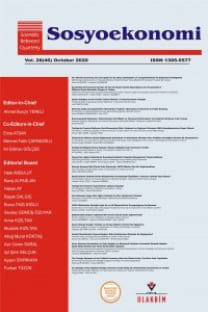Türkiye'de sübjektif yoksulluk profili: 2003 2008
Subjective poverty profile in Turkey: 2003 2008
___
- Bağdadioğlu, N. ve A.A. Başaran (2010), Poverty Perception and Governments Transfer Policy in Turkey, The Empirical Economics Letters, 10(4), 317-325.
- Colasanto, D., A. Kapteyn ve J. Van der Gaag (1984), Two Subjective Definitions of Poverty: Results from the Wisconsin Basic Needs Study, The Journal of Human Resources, 19(1), 127-138.
- Danziger, S., J. Van der Gaag, M.K. Taussig ve E. Smolensky (1984), The Direct Measurement of Welfare Levels: How Much Does it Cost to Make Ends Meet?, The Review of Economics and Statistics, 66(3), 500-505.
- De Vos, K. ve T.I. Garner (1991), An Evaluation of Subjective Poverty Definitions: Comparing Results from the U.S. and the Netherlands Review of Income and Wealth 37(3), 267- 285.
- DPT (2007), Gelir Dağılımı ve Yoksullukla Mücadele Özel İhtisas Komisyonu Raporu 2007-2013, Yayın No: DPT: 2742- ÖİK: 691.
- Flik, R.J. ve B.M.S. Van Prag (1991), Subjective Poverty Line Definitions, De Economist, 139(3), 311-330.
- Garner, I.T. ve K. de Vos (1995), Income Sufficiency V. Poverty: Results from the United States and the Netherlands, Journal of Population Economics, 8(2), 117-134.
- Garner, I.T. ve K.S. Short (2005), Personal Assessments of Minimum Income and Expenses: What Do They Tell Us about Minimum Living Thresholds and Equivalence Scales?, BLS Paper No. 379, U.S. Department of Labor Bureau of Labor Statistics.
- Goedhart, T., V. Halberstadt, A. Kapteyn ve B. Van Prag (1977), The Poverty Line: Concept and Measurement, The Journal of Human Resources, 12(4), 503-520.
- Gustafsson, B., L. Shi ve H. Sato (2004), Can a Subjective Poverty Line be Applied to China? Assessing Poverty among Urban Residents in 1999, Journal of International Development, 16(8), 1089-1107.
- Hagenaars, A. ve K. De Vos (1988), The Definition and Measurement of Poverty, The Journal of Human Resources, 23(2), 211-221.
- Herrera, J., M. Razafindrakoto ve F. Roubaud (2006), The Determinants of Subjective Poverty: A Comparative Analysis between Madagascar and Peru, Institut de Recherche Pour le Developpement, DT/2006-01.
- Kapteyn, A., P. Kooreman ve R. Willemse (1988), Some Methodological Issues in the Implementation of Subjective Poverty Definitions, Journal Of Human Resources 23(2), 222-242
- Lanjouw, P. ve M. Ravallion (1995), Poverty and Household Size, The Economic Journal, Vol. 105(433), 1415-1434.
- Milanovic B, ve B. Jovanovic (1999), Changes in the Perception of the Poverty Line during Times of Depression: Russia 1993-96, Policy Research Working Paper No. 2077, World Bank Country Economics Department, New York.
- Pradhan M. ve M. Ravallion (2000), Measuring Poverty Qualitative Perceptions of Consumption Adequacy, The Review of Economics and Statistics 82(3), 462-461.
- Saunders, P., B. Halleröd, ve G. Matheson, (1994), Making Ends Meet in Australia and Sweden: A comparative Analysis Using the Subjective Poverty Line Methodology, Acta Sociologica, 37(1), 3-22.
- Sen, A. (1976), Poverty: An Ordinal Approach to Measurement, Econometrica, 44(2), 219-231.
- Van Praag, B., T. Goedhart ve A. Kapteyn (1980), The Poverty Line-A Pilot Survey in Europe, The Review of Economics and Statistics, 62(3), 461-465.
- Türkiye İstatistik Kurumu (TUİK), 20032008, Hanehalkı Bütçe Anketi Mikro Veri Seti.
- Türkiye İstatistik Kurumu (TUİK), 20032008, Yoksulluk Çalışması Haber Bülteni, _____http://www.tuik.gov.tr/ZipGetir.do?id=25&class=onceki>, Erişim: 24.07.2009.
- ISSN: 1305-5577
- Yayın Aralığı: 4
- Başlangıç: 2005
- Yayıncı: Sosyoekonomi Derneği
Otel Sektöründe Yenileme Yatırımlarının Finansmanı: Marmaris'te Bir Araştırma
Önder MET, İsmail ÖZDEMİR, Barış ERDEM
Otel sektöründe yenileme yatırımlarının finansmanı: Marmaris'te bir araştırma
Önder MET, Barış ERDEM, İsmail Mert ÖZDEMİR
Yerel Yönetimlerin Finansman Sorunlarının Çözümünde Motorlu Taşıtlar Vergisi Önerisi
Türk Bankacılık Sektöründe Etkinlik Analizi
Ekonomik Gerçeklik Olgusu: Yeni Kavramsal Yaklaşım
